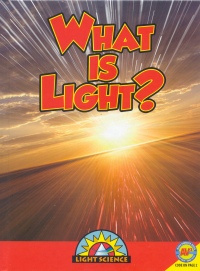| ________________
CM . . . . Volume XVIII Number 24 . . . . February 24, 2012
excerpt:
Simon Rose, author of What is Light?, attempts to answer the question posed by the title. His answer, however, may not be one that makes sense to the readers for whom the book has been written. As the first excerpt above suggests, Rose writes that light is a form of energy that is called electromagnetic energy because it is made up of changing electric and magnetic fields. No further attempt is made to help eight to twelve-year-olds understand this information. Itís as if knowing these scientific facts is all that is necessary for developing an ability to think scientifically about light. As one progresses through the 24 pages of the book, concepts such as light speed, the visible light spectrum, radio waves, gamma rays, primary colours of light, cornea, retina, optic nerve, reflected light, absorbed light, shadows, physics, and optics are encountered. Like the concept light, they are presented in a way that makes one seem as if this is all one needs to know. Using the second excerpt as an example, readers are led to believe that of transparent, translucent and opaque objects, only those that are opaque cast a shadow. Is this actually the case? The single activity in the book, found on page 22, encourages an investigation of shadow size using a flashlight and glass containing milk. Itís obvious from the accompanying illustration that the part of the glass holding the milk casts a shadow onto the tabletop. If the liquid was translucent, would there be a shadow? Would an empty translucent container cause a shadow to form? How about an empty transparent container? These are the kinds of investigations that need to be carried out by young learners in order to begin to understand what happens to light when it strikes an object and the reasons for a shadow. If there is a unique component to What is Light?, itís that it is one of publisher Weiglís media enhanced books. This means that using a book code on page two, itís possible to logon to www.av2books.com and access a website that presents miniatures of each two page spread from the book and offers more factual information about light using embedded web links and video clips. There are also tests of the factual knowledge presented in the book and a link to ďSid the Science KidĒ where one can make a shadow shown on a flash card by selecting and arranging two geometric shapes on a grid and switching on a light. Unfortunately, this web based enhancement has the feel of a teacher made web quest that was put together too quickly. What is Light? includes a table of contents, a glossary that provides definitions for terms in bold font in the text, and an 18 item index. There is also a simple light discovery timeline that begins with Plato (400 BC) who proposed that rays coming from the eyes enabled humans to see and ends with verification of Einsteinís 1905 suggestion that light consists of particles called photons. Each page of the book is illustrated with stock photographic images and diagrams from Getty Images. Not Recommended. Barbara McMillan is a teacher educator and a professor of science education in the Faculty of Education, the University of Manitoba.
To comment
on this title or this review, send mail to cm@umanitoba.ca.
Copyright © the Manitoba Library Association. Reproduction for personal
use is permitted only if this copyright notice is maintained. Any
other reproduction is prohibited without permission.
NEXT REVIEW |
TABLE OF CONTENTS FOR THIS ISSUE
- February 24, 2012.
AUTHORS |
TITLES |
MEDIA REVIEWS |
PROFILES |
BACK ISSUES |
SEARCH |
CMARCHIVE |
HOME |
